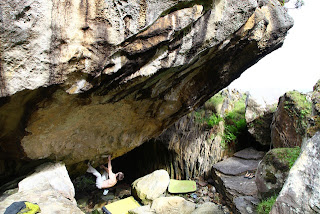Summer Bouldering

The sandstone boulders under the cliffs of Raasay have seen some serious attention from top-end climbers Michael Tweedley and Dave MacLeod. Dave reported an amazing and very continental-looking project on the giant boulders round Screapadal. Dave reports on the stunning potential of the area in his blog:
'We spent ages looking round the boulders finding countless problems in the V0-V3 range that looked great, but not much for ourselves. But finally we stumbled upon one line that changed our psyche - the biggest, baddest Font 7c/+ roof in Scotland!'
Beastmaker Dan Varian has written a hilarious blog about the ups and downs of Scottish bouldering, cranking out some big new testpieces in Torridon and Applecross in June. Lovingly entitled '3 days in Paradise, 1 day in a Shithole', you can tell he wasn't impressed by Dumbarton! Don't worry, Dan, we feel you and are trying to get the place cleaned up! See here for further developments on the clean-up and development of Dumbarton Rock via the MCOS >>>.
Wee Baws, 7b, Torridon
Ann Falconer, Nigel Holmes and others developed some more accessible circuit problems at Coire nan Arr around the Dam boulder and on the excellent wee boulder across the loch, with possibly the cleanest rock in Scotland! The dam area is extremely accessible and has a good mix of hard lines, projects and perfect 4 to 6a problems.
Ann Falconer on a Coire nan Arr traverse
In the south, a few Glasgow-based climbers have been developing Arran's remoter corries with some enjoyable circuit-style bouldering and the odd 'blankety blank cheque book and pen' i.e. any granite testpiece:
The Whangie has seen some attention as a summer venue for boulderers. This crumbly crag, long a classic trad ground for developing nerve and control on poor rock, actually has an enjoyable circuit of problems from Font 4 to 6c, with the Traverse proving a camouflaged classic 6c - very hard to onsight! If you're limited to an evening's bouldering and want to escape the midges, this will catch any breeze going and the outlook is biscuit-tin classic.
The Whangie >Andy's Lip 6a+


